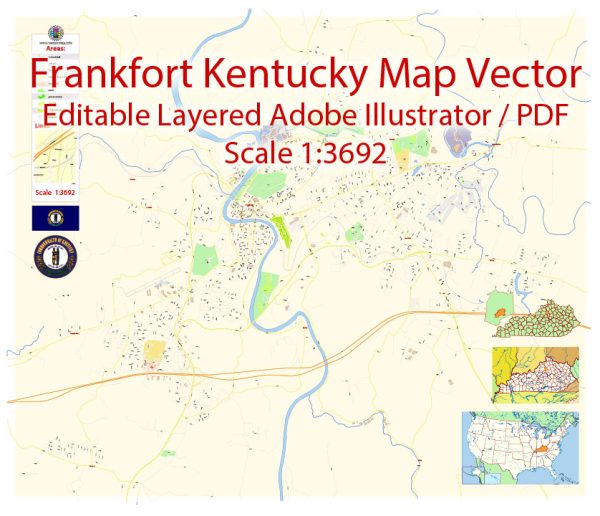Frankfort, the capital city of Kentucky, has a rich history that is reflected in its urban development. Here is an overview of the historical urban development of Frankfort, Kentucky:
- Founding and Early Settlement (Late 18th Century):
- Frankfort was founded in the late 18th century. The city’s location on the Kentucky River made it a strategic point for settlement and trade.
- It was named after Stephen Frank, an early settler. The city was officially established in 1786 and became the state capital in 1792 when Kentucky was admitted to the Union.
- Antebellum Period (19th Century):
- During the 19th century, Frankfort experienced growth as a political and commercial center.
- The construction of the Old State Capitol, completed in 1830, is a significant architectural landmark. It served as the seat of Kentucky’s government until 1910.
- Civil War Era:
- Frankfort was occupied by both Union and Confederate forces during the Civil War. The city played a role in the conflict, and its development was influenced by wartime activities.
- Post-Civil War Reconstruction:
- After the Civil War, Frankfort underwent a period of reconstruction and recovery. The city continued to grow as an industrial and transportation hub.
- Industrialization (Late 19th to Early 20th Century):
- The late 19th and early 20th centuries saw industrialization in Frankfort. The growth of industries, including bourbon distilleries, contributed to economic development.
- 20th Century Development:
- Frankfort continued to modernize in the 20th century. The expansion of infrastructure, including roads and utilities, facilitated further growth.
- The construction of the new State Capitol, dedicated in 1910, marked another important phase in the city’s architectural history.
- Mid to Late 20th Century:
- Urban development in the mid to late 20th century saw changes in transportation and housing patterns. Suburbanization became a trend, and new neighborhoods were developed.
- Preservation Efforts:
- Efforts to preserve and promote the historical significance of Frankfort’s architecture and sites have been ongoing. The city has several districts listed on the National Register of Historic Places.
- Contemporary Urban Development:
- Today, Frankfort maintains a balance between preserving its historical character and fostering modern development. The city has seen revitalization efforts, including the development of cultural and recreational spaces.
- Cultural and Educational Institutions:
- Frankfort is home to cultural and educational institutions like the Kentucky Historical Society and the Thomas D. Clark Center for Kentucky History, contributing to the city’s identity and attracting visitors.
Frankfort’s urban development reflects its historical significance as the capital of Kentucky, and the preservation of its architectural heritage is an ongoing priority for the community.


 Author: Kirill Shrayber, Ph.D.
Author: Kirill Shrayber, Ph.D.